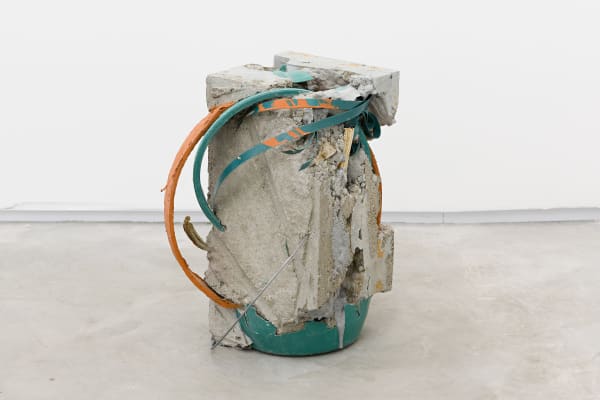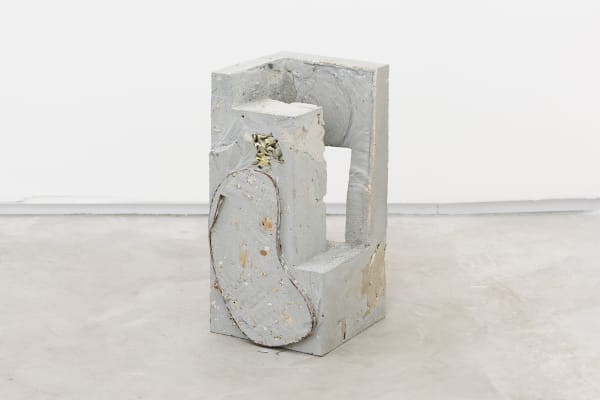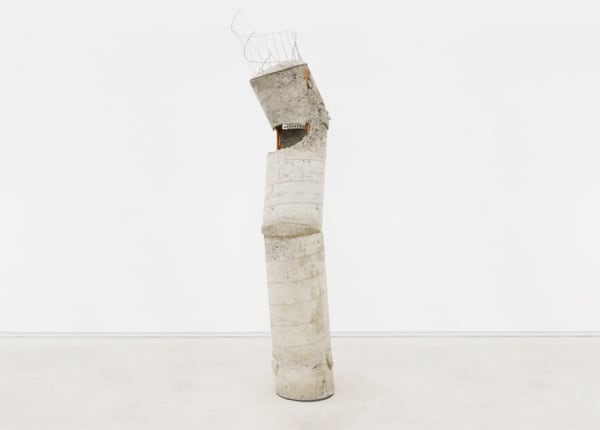Work Over Time Allyson Vieira
Mendes Wood DM is pleased to present the first solo show of American artist Allyson Vieira in Brazil. "Work Over Time" is a new body of sculptural work produced during her two-month residence in the city of São Paulo.
In this exhibition Vieira once again confronts the relationship between architecture and art and how each affects and situates itself in the construction of contemporary societies. An avid visitor of ancient sites, she presents us with sculptures that evoke structures of the past, yet are uncomfortably of the present.
The notion of time as an essential dimension of sculpture has long been a primary concern in Vieira's work. "Work Over Time" is a simple phrase that can be read in three distinct ways: To "work overtime" is to work extra hours, to perform additional labor beyond what one has been contracted for. The phrase "work, over time" describes the duration of the objects of human labor, highlighting the fact that all objects have four dimensions -- not merely three. Finally, "work over time," or "W/t" can be read as a part of the physics equation W/t=P, or "Work over Time equals Power."
A long-time resident of New York City, Vieira has seen the effects of globalization and the process of gentrification in the city firsthand. She observes the fast-paced rhythms of both New York's and São Paulo's ongoing verticalizations and lives among the New York’s ever-multiplying demolition and construction sites. Her work balances on the edge between something being built and something being destroyed, between what once was and what is becoming. By occupying that liminal space, Vieira confounds our linear vision of time, uniting past and future in her objects, making the present an impossible place to be.
Vieira employs mundane construction materials in the local vernacular. Living and producing her works in the city where they are to be shown has become an essential element of her practice, allowing the urban character of each locale to permeate the works via materials, form, and process. For this exhibition she has produced her first two series of works in concrete: Workers 1-7 and Blocks 1-16.
Workers 1-7 are concrete and steel works cast in cardboard tube forms commonly used for quickly and inexpensively casting load-bearing support columns. Vieira does not employ advanced or highly technical architectural means to create her works. Rather, they are made by hand using rudimentary techniques in an improvisational manner. Looking at Michel Gautherot's photos of the building of Brasilia, one is struck by the seeming contradiction that "space age" buildings were made using the simplest materials: wooden forms, steel bars, poured concrete, and a massive supply of laborers, the evidence of whose hands was later erased through finishing. In the Workers there is no finishing, no magic. All the means of construction are visible, as are the effects of work on the body. The figures hang in tired contrapposto. Though made with rough materials the Workers have an almost fragile character, like bodies that can barely remain standing. They suggest “work” not only in its political and economic sense, but also as literal, physical exertion.
Blocks 1-16 are the same dimensions as the two most common concrete blocks used in Brazil and the United States. They are cast and carved from an amalgam of concrete and scrap material from the Workers and their Block predecessors, creating a muddled index of the exhibition's manufacture. Their materials are improvised and provisional; everything usable is reused. They sit on the floor, as the viewer towers over them; they are the blocks that build our buildings, but also the blocks that form our cities. As such, they are simultaneously the unit form and the whole -- material and architecture.
Between the Blocks and the Workers hangs a curtain of construction debris netting, Over. Ubiquitous in cities of growing towers, debris netting sheathes new construction in ghostly gauze, separating the messiness of work and workers from the city at large. Here, the netting passes through the door, dividing the two galleries into four spaces and the two bodies of work from each other. One must pass through the netting to access the second gallery. Over is the slash that separates the divisor from the dividend, a semi-permeable barrier that both pre- and proscribes interaction between them.
Allyson Vieira was born in Massachusetts in 1979. She lives and works in New York.
Her work has been presented internationally, including a recent museum solo show, The Plural Present at Kunsthalle Basel, Basel, Switzerland (2013), which traveled to Swiss Institute, New York (2013-14). Other international institutional presentations include the exhibition of finalists for the Future Generation Art Prize, PinchukCentre, Kiev, UA (2014-2015), and Build On, Build Against, with Stephen Ellis at Non Objectif Sud, Tulette, France (2013). In the U.S., her work has been featured Remainder, Philbrook Museum of Art, Tulsa, OK (2013), A Handful of Dust, Santa Barbara Contemporary Arts Forum (2013), Configurations, Public Art Fund, Brooklyn, NY (2012), Lilliput, The Highline, New York (2012), and Knight’s Move, Sculpture Center, Long Island City, NY (2010). Vieira’s work has also been included in shows at The Sunday Painter, London (2015), Eleven Rivington, New York (2012), Klaus von Nichtssagend, New York (2011), Brown Gallery, London (2009), and 179 Canal Street, New York (2009). Her work has been covered by major publications, including The New York Times, The New Yorker, Artforum, Frieze, Modern Painters, Architectural Record, Du, and Art in America.













